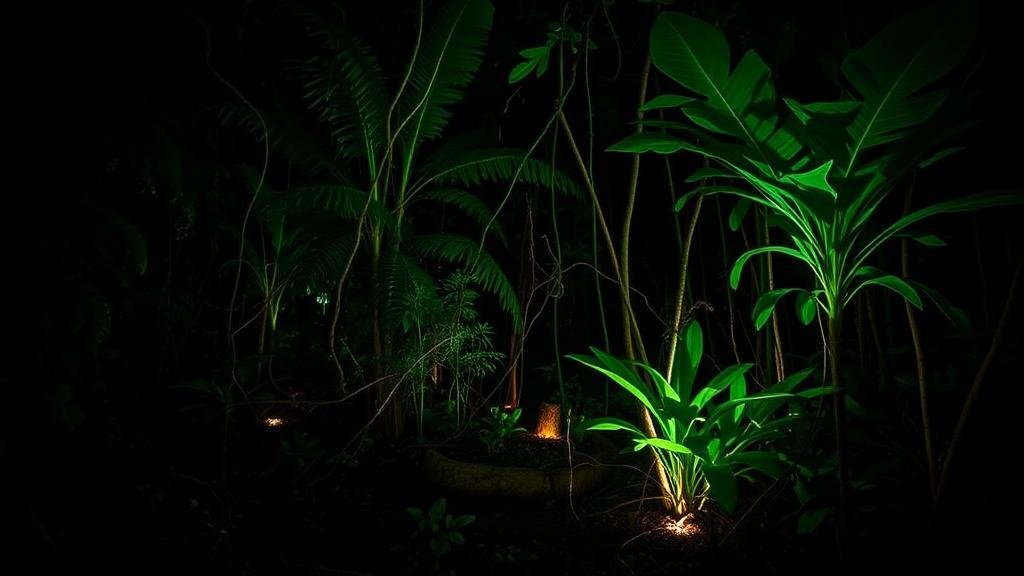Searching for unique bioluminescent plants in the Amazon Basin tied to Indigenous medicinal practices.
Searching for Unique Bioluminescent Plants in the Amazon Basin Tied to Indigenous Medicinal Practices
The Amazon Basin, spanning across nine countries and housing one-tenth of all species known on Earth, serves as a treasure trove of biodiversity. Among its myriad of wonders are bioluminescent plants, which have captivated scientists and locals alike. These plants not only illuminate the forest floor at night but also hold a reservoir of knowledge embedded in Indigenous medicinal practices. Exploring this connection between bioluminescence and indigenous healing traditions sheds light on both the ecological significance and cultural heritage of the Amazon.
The Science of Bioluminescence
Bioluminescence refers to the ability of living organisms to produce light through biochemical reactions. This phenomenon is largely attributed to the enzyme luciferase and a light-emitting molecule known as luciferin. In the Amazon, certain plant species exhibit bioluminescence, with examples including Myriophyllum spicatum and some fungi. e organisms thrive in the warm, humid conditions typical of the region and often glow in shades of green and blue, creating mesmerizing displays that can light up entire areas of the forest.
Research conducted in 2021 revealed that bioluminescent plants play a vital role in attracting pollinators, which is essential for ecosystem stability. A study published in the journal Botanical Studies showcased that these plants could potentially enhance biodiversity by contributing to more robust plant-pollinator relationships.
Historical Context of Indigenous Medicinal Practices
Indigenous cultures have inhabited the Amazon for thousands of years, and their medicinal practices are deeply intertwined with the surrounding flora. Many Indigenous communities, such as the Shipibo-Conibo and Yanomami, have a profound understanding of local plants therapeutic properties, often utilizing them in rituals and for healing. integration of bioluminescent plants into their traditional healing practices is an area that has only recently begun to attract research attention.
- For example, the Shipibo-Conibo people use infusions made from specific bioluminescent plants to treat ailments such as skin infections and digestive issues.
- Plus, some Indigenous healers believe that these glowing plants carry spiritual significance, symbolizing the connection between life and the cosmos.
Case Study: The Use of Bioluminescent Plants in Healing
A notable example is the utilization of the bioluminescent moss Dicranum scoparium, which has been used by native healers to prepare poultices. Indigenous shamans often consider its luminous properties indicative of light’ healing energy, which is believed to enhance the effectiveness of medicinal brews.
In a collaborative study with local tribes in 2022, researchers documented how the infusion from this moss, when applied topically, significantly reduced inflammation and promoted healing in subjects with chronic wounds. This case underscores the importance of bioluminescent flora as not only a biological curiosity but also a functional component of Indigenous medical practice.
Conservation Challenges and Opportunities
Despite the significance of bioluminescent plants, they face numerous threats from deforestation, climate change, and industrial exploitation. ongoing plight of the Amazon rainforest brought to light by the 2021 Global Forest Watch report, which indicated that over 1 million hectares of Amazonian forest were lost in 2020 alone, highlights the urgent need for conservation efforts.
Local Indigenous communities are key to conservation strategies, as their traditional knowledge fosters sustainable practices. Initiatives such as the “Indigenous Protected Areas†movement aim to empower these communities to manage their lands, ensuring the survival of bioluminescent plants and the traditional practices tied to them.
Moving Forward: Research and Cultural Preservation
Future research into the ecological roles and pharmacological properties of bioluminescent plants presents untapped potential for medicine and conservation. Collaborations between scientists and Indigenous communities can lead to valuable insights, fostering pathways for understanding the links between biodiversity and cultural heritage.
- Establishing biocultural conservation initiatives can enhance preservation efforts while supporting Indigenous livelihoods.
- Bioluminescent plants may also inspire new technologies in renewable energy and biomedicine, similar to how substances derived from other natural sources have led to breakthroughs in modern medicine.
Conclusion
Searching for unique bioluminescent plants in the Amazon Basin reveals a captivating intersection of biodiversity and cultural practices rooted in Indigenous knowledge. e remarkable organisms not only serve as crucial components of the ecosystem but also contribute to a rich tapestry of traditional healing practices. As we aim to safeguard the Amazonian biome, recognizing the significance of bioluminescent plants and nurturing Indigenous custodianship is essential for the future of both ecological and cultural diversity.



